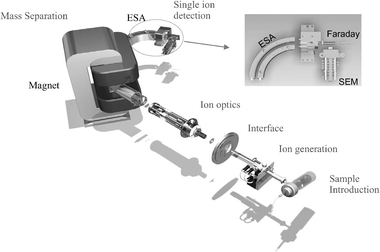THERMO Element XR High-resolution ICP-mass spectrometer (HR-ICP-SFMS)
Instrument
Double focussing sector field high-resolution ICP-mass spectrometer (HR-ICP-SFMS)
Technical Data/Features
- fixed low (400), medium (4000) and high (10,000) mass resolution
- Triple detector for enhanced dynamic range covering 12 orders of magnitude
- High response 1.5 Ghz/ppm
- low background <0.2cps result in ultimate limits of detection < 10-15
- New 2014 installation replacing former PlasmaTrace PT2 high resolution ICP-MS
Inductively coupled plasma à mass spectrometry (ICP-MS) is a powerful method for the determination of the (trace) element chemical composition of a sample. A mass spectrometer (MS) separates ionized elements and isotopes according to their mass-to-charge ratio (m/z) for subsequent quantification. Samples are introduced as liquids after pneumatic nebulization, or as dry aerosols after desolvation or laser ablation. The inductively coupled argon plasma (ICP) with temperatures of ?6000 K is the ion source of the MS. Ions formed in the ICP are extracted through the interface into the high vacuum part of the MS, accelerated by high voltage and focused through an entrance slit with variable slit width towards the sector field mass filters by ion optics (quadrupole lenses for beam shaping). Ions flying on a curved flight path first pass the magnetic sector where their flight path is depending on the ionsà mass-to-charge ration (m/z). In the subsequent electrostatic sector (ESA) ions are separated according to their kinetic energy. Scanning of different masses (m/z) is accomplished by both varying acceleration voltage (E scan) and/ or the magnetic field (magnet scan). Finally, ions path through an exit slit and arrive at a triple stage detection system comprising of a Faraday detector for high ion counts and a dual stage secondary electron multiplier (SEM) for low to high count rates. The combined dynamic range of the detectors is 1012 cps. Note: This is not a multi-collector instrument. The extreme instrument response of 1.5 GHz/ppm combined with very low background counts <0.2cps results in ultimate limits of detection < 10-15. Changeable widths of both entrance and exit slits control the final mass resolution of the entire MS and can be set to 400, 4000, and 10000MR.
Application
Routinely used for ultra-trace element analysis, for determination of radionuclides (e.g., 230Th) and isotopic composition (e.g., 206Pb/207Pb, d11B, 87Sr/86Sr) for extremely small sample sizes, samples with difficult matrices (seawater, life sciences), and direct in situ micro-analysis of solids by laser ablation.
Keywords
Mass Spectrometry, Isotope and Trace Element Analysis, Materials Analysis, Life Science, Radionuclide

